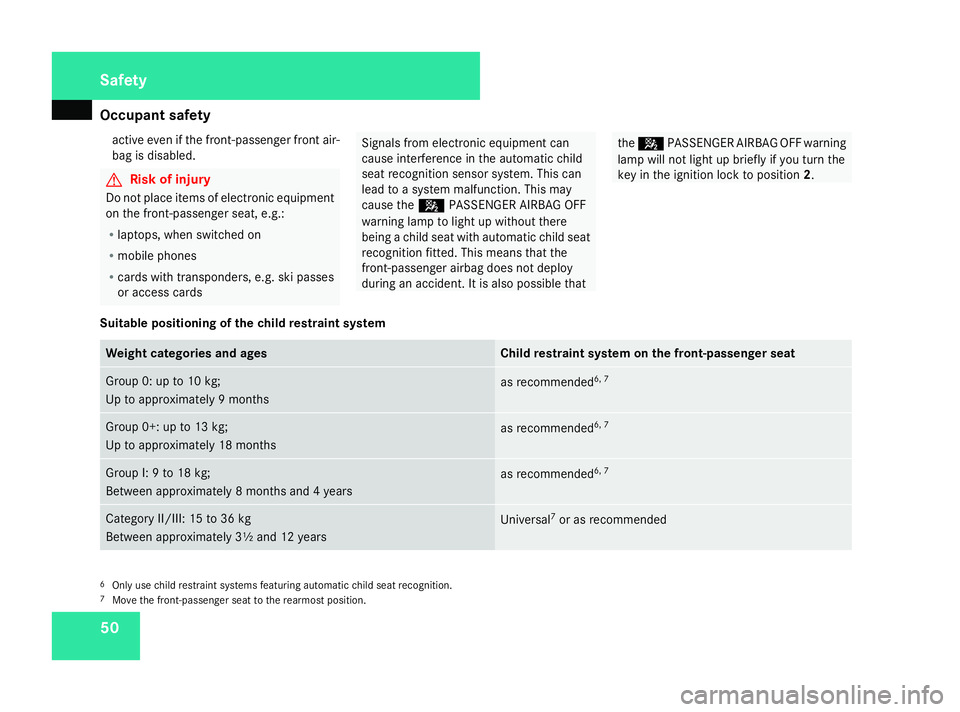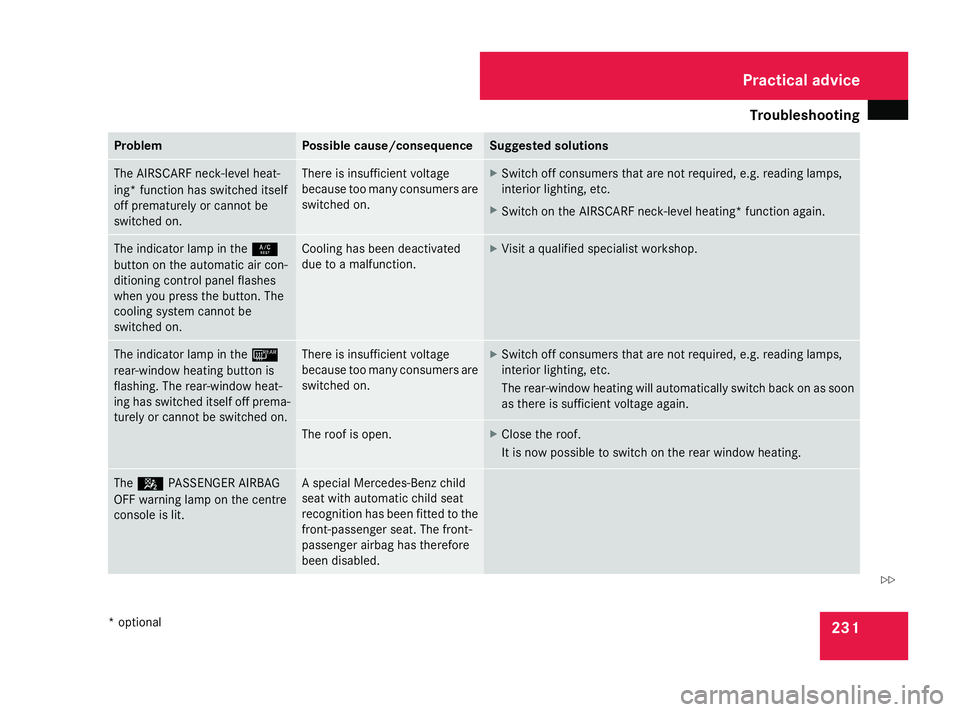2008 MERCEDES-BENZ SL ROADSTER airbag disable
[x] Cancel search: airbag disablePage 46 of 317

Occupant safety
43
R
in the event of ahead-on or rear-en dcolli-
sion if the vehicle decelerates or acceler-
ates rapidly in alongitudinal direction
during the initial stages of the impact
R in certain situation sifthe vehicle over-
turns, and the system determines that it
can provide additional protection
R on the front-passenger side only if the
front-passenger seat is occupied and the
belt tongue is engaged in the buckle
If the belt tensioners are triggered you will
hear abang, which will not cause any harm to
your hearing, and asmall amount of powder
may also be released. The 1warning lamp
lights up. G
Risk of injury
If the seat belt tensioners have been trig-
gered, they provide no additional protec-
tion in the event of another accident.
Therefore, have belt tensioners which have
been triggered replaced at aqualified spe-
cialist workshop.
Comply with safety regulations when dis-
posing of belt tensioners .Any Mercedes-
Ben zService Centr ecan provide details of
these regulations. Airbags Airbag deployment slows down and restricts
the movement of the vehicle occupant.
If the airbags are deployed you will hear a
bang, which will not cause any harm to your
hearing, and
asmall amount of powder may
also be released. The 1warning lamp
lights up.
The SRS/AIRBAG identification indicates the
location of the airbags. G
Risk of injury
Airbags provide additional protection ;they
are not ,however, asubstitute for the seat
belts.
Observe the following notes to reduce the
risk of serious or even fatal injury if an air-
bag is deployed:
R all vehicle occupants —inparticular preg-
nant women —must wear their seat belt
correctly at all times and lean back
against the backrest, which should be
positioned as close to the vertical as pos-
sible. The head restraint must support
the back of the head at about eye level.
R alway ssecure children less than 1.5 0m
tall or under 12 years of age in suitable
child restraint systems. R
all vehicle occupants must select aseat
position that is as far away from the air-
bag as possible. The driver's seat posi-
tion must allow the vehicle to be driven
safely. The driver's chest should be as far
away from the middle of the driver's front
airbag cover as possible.
R move the front-passenger seat as far
back as possible, in particular, if achild
is secured in achild restraint system on
the seat.
R vehicle occupants –inparticular, chil-
dren –must not lean their head on the
area of the window from which ahead/
thorax airbag is deployed.
R rearward-facing child restraint systems
must not be fitted to the front-passenger
seat unless the front-passenger fron tair-
bag has been disabled. The front-
passenger fron tairbag is disabled if a
child restraint system with automatic
child seat recognition is fitted to the
front-passenger seat. The
5 PASSENGER AIRBAG OFF warning
lamp must be constantly lit.
If you secure aforward-facin gchild
restraint system to the front-passenger Safety
230_AKB
;5;4,en-GB
bjanott, Version:2.9.6
2008-04-08T15:09:54+02:0
0-Seite 43 ZDateiname: 6515_3089_02_buchblock.pdf; preflight
Page 51 of 317

Occupant safety
48 forces occurring in the event of
asudden
chang eofdirection, heavy brakin goran
accident, it would not be possible to
restrain the child. The child could be
thrown against parts of the vehicle inte-
rior and be seriously or even fatally
injured. G
Risk of injury
If the child restraint system is not correctly
fitted to asuitable vehicle seat, it cannot
perfor mits protective function .The child
cannot be restrained in the event of asud-
den chang eofdirection, heavy brakin gor
an accident. This may lead to serious or
even fatal injuries. For this reason, when
fitting achild restraint system, observe the
manufacturer's installation instructions
and the correct use of the child restraint
system.
The entire base of the child restraint system
must alway srest on the seat cushion.
Never place objects, e.g. acushion ,under
the child restraint system.
Only use child restraint systems with their
original covers. Only replace damaged cov-
ers with genuine Mercedes-Benz covers. For safety reasons
,you should only use
child restraint systems which have been
approved for use in Mercedes-Benz vehi-
cles.
Child seat on the front-passenger seat Warning on the front-passenger sun visor Warning symbol for
arearward-facing child
restraint system G
Risk of injury
If the front-passenger front airbag is not
disabled:
R ac hild secured in achild restraint system
on the front-passenger seat could be
seriously and even fatally injured by the
front-passenger front airbag deploying.
This is especially arisk if the child is in
the immediate vicinity of the front-
passenger front airbag when it deploys.
R ac hild must never be secured on the
front-passenger seat in arearward-facing
child restraint system.
R always move the front-passenger seat to
the rearmost position if you secure a Safety
230_AKB; 5; 4, en-GB
bjanott
,V ersion: 2.9.6
2008-04-08T15:09:54+02:00
-Seite 48 Dateiname: 6515_3089_02_buchblock.pdf; preflight
Page 53 of 317

Occupant safety
50activ
eeven if the front-passenger fron tair-
bag is disabled. G
Risk of injury
Do not place items of electronic equipment
on the front-passenger seat, e.g.:
R laptops, when switched on
R mobile phones
R cards with transponders, e.g. ski passes
or access cards Signals from electronic equipment can
cause interference in the automatic child
seat recognition sensor system. This can
lead to
asystem malfunction .This may
cause the 5PASSENGER AIRBAG OFF
warning lamp to light up without there
being achild seat with automatic child seat
recognition fitted. This means that the
front-passenger airbag does not deploy
during an accident. It is also possible that the
5 PASSENGER AIRBAG OFF warning
lamp will not light up briefly if you turn the
key in the ignition lock to position 2.
Suitable positioning of the child restraint system Weight categories and ages Child restraint system on the front-passenger seat
Group 0: up to 10 kg;
Up to approximately
9months as recommended
6, 7 Group 0+: up to 13 kg;
Up to approximately 18 months
as recommended
6, 7 Group I:
9to18k g;
Between approximately 8months and 4years as recommended
6, 7 Category II/III: 15 to 36 kg
Between approximately 3½ and 12 years
Universal
7
or as recommended 6
Only use child restraint systems featurin gautomatic child seat recognition.
7 Move the front-passenger seat to the rearmost position. Safety
230_AKB
;5;4,en-GB
bjanott, Version:2.9.6
2008-04-08T15:09:54+02:0
0-Seite 50 Dateiname: 6515_3089_02_buchblock.pdf; preflight
Page 234 of 317

Troubleshooting
231Problem Possible cause/consequence Suggeste
dsolutions Th
eA IRSCARF neck-leve lheat-
ing *functio nhasswitched itself
off prematurel yorcannot be
switched on. There is insufficient voltage
because too many consumers are
switched on. X
Switch off consumers tha tare not required ,e.g.r eading lamps,
interior lighting ,etc.
X Switch on the AIRSCARF neck-leve lheating* functio nagain. Th
eindicator lamp in the 9
button on the automatic ai rcon-
ditioning control panel flashes
when yo upress the button. The
cooling syste mcannot be
switched on. Cooling ha
sbeend eact ivated
du etoam alfunction. X
Visi taq ualified specialis tworkshop. Th
eindicator lamp in the ¯
rear-window heating button is
flashing. Th erear-window heat-
ing ha sswitched itsel foff prema-
turel yorc annot be switched on. There is insufficient voltage
because too many consumers are
switched on. X
Switch off consumers tha tare not required ,e.g.r eading lamps,
interior lighting ,etc.
Th er ear-window heating will automaticall yswitch back on as soon
as there is sufficient voltag eagain. Th
er oofiso pen. X
Clos ethe roof.
It is now possibl etoswitch on the rea rwindo wh eating. The
5 PASSENGER AIRBAG
OFF warning lamp on the centre
consol eislit. As
pecial Mercedes-Benz child
seat with automatic child seat
recognition ha sbeenf itted to the
front-passenge rseat. Th efront-
passenge rairba gh astherefore
been disabled. Practical advice
*o ptional
230_AKB; 5; 4, en-GB
bjanott,
Version: 2.9.6 2008-04-08T15:09:54+02:00-Seite 231 ZDateiname: 6515_3089_02_buchblock.pdf; preflight